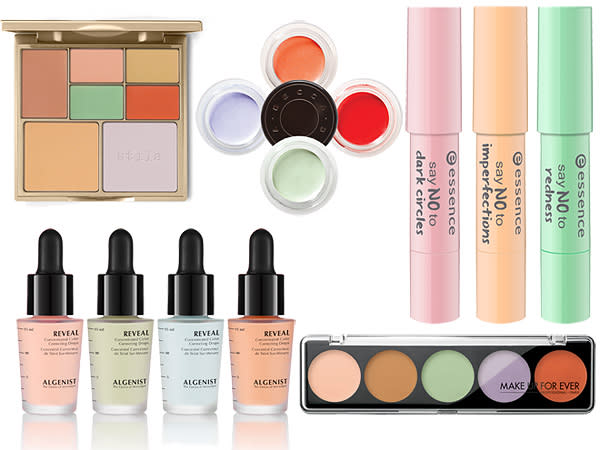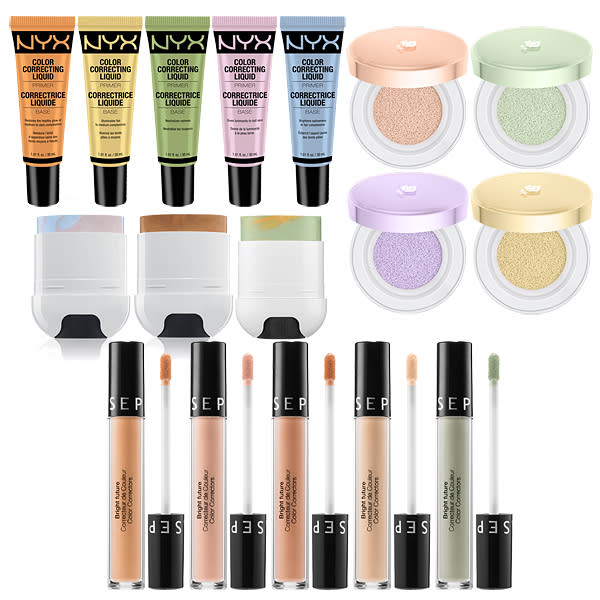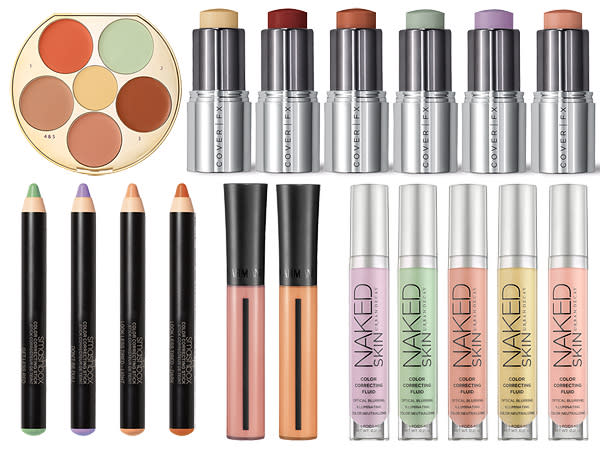Color-Correcting 101: Everything You Need to Know About This Summer's Biggest Skin Trend

Move over, contouring, strobing and nontouring, there’s a new makeup trend in town, and it’s here to make you re-think your concealer game. Color-correcting, the art of painting your face with brightly hued coverups in lieu of average concealers, is taking over the beauty world (and sending users back to art class).
What Is Color-Correcting?
Tim Quinn, Giorgio Armani celebrity makeup artist, breaks down the technique in the simplest form: “Color-correcting is the process of using color tones to neutralize issues on the face by taking its cue from the color wheel,” he tells PeopleStyle. “The basic goal is to make the complexion more harmonious by disguising any color imperfections.”
Cosmetics companies, including Urban Decay, Giorgio Armani, Stila Cosmetics, Make Up For Ever and many more, have tapped into the color-correcting madness this season, launching products to target (and cover up) skin issues (i.e., redness, blemishes, dark circles, etc.) with shades in greens, purples, pinks, peaches and yellows.
For example, green hues neutralize red-tinted issues, including rosacea, acne, broken capillaries and sunburn, says Sarah Lucero, celebrity makeup artist and global artist director for Stila Cosmetics. Quinn adds, green is also “terrific for camouflaging blemishes.”
Peach and orange-colored formulas target blue and purple-tinted dark circles, commonly found under the eyes on most skin tones, while pink creams brighten and highlight the eye area to “help mask fatigue,” says Lucero. “I like to use pink creams after peach to brighten up any areas like the corners of mouth, smile lines and also under the brow bone,” she tells PeopleStyle. “If you are looking tired, use pink cream — it’ll wake up your makeup!”
Yellow correctors target purple and brown trouble areas, such as hyperpigmentation, bruising and dark spots, and they’re great for concealing sun damage on the cheeks and forehead, says Lucero.
RELATED VIDEO: Beauty Hack: The Key to Your Best Skin Ever Is in Your Fridge

Finding Your Perfect Shade
Figuring out which shade to tackle your skin issue(s) is the first step in the color-correcting process, but it’s also important to consider other variables, such as your skin tone (fair, medium or dark) and skin type (normal, oily, dry or combination).
“Fair and darker skin tones respond well to pink correctors for under-eye issues, while peach-tinted concealers tend to work better with medium to olive-toned complexions,” says Quinn, adding that yellow and green shades are universally flattering and work with most skin tones.
Depending on your skin type, certain color-correctors might be better suited for your complexion. While cream formulas work well with just about every skin type, those who boast dry or oily mugs might find liquid or serum-based correctors to be their perfect pair, says Lucero.
Because you might have a number of areas of concern (for example: You’re suffering from a breakout but also have hyperpigmentation), more than one shade can be used in different areas of your face. So before jumping in with a corrector, analyze your bare face to determine the opposite color you’ll need to correct your issue(s).
“We get more red around the nose, mouth, and cheeks,” says Lancôme national makeup artist Darais. “Purples and blues happen more under the eyes, while shallowness and yellowing can happen more on an olive complexion on the forehead or temples.”
RELATED PHOTOS: Buy It Now: Beauty Trends We’re Loving — and Exactly How to Get Them
And remember that these concerns might not be the same as yesterday’s — your skin’s needs can change overnight, depending on a number of variables, says Lucero. “There will be days when you wake up and decide to use one shade or more based on how you look,” she tells PeopleStyle. “The elements of the seasons can bring on allergies, which might cause terrible under-eye circles, or your regular concealer just isn’t doing the trick like it once did.”
Which is why Lucero recommends mixing and adjusting shades to suit your area of concern. “Say you are fair and you have very dark circles with a blue tint under your eyes, you’ll need extra peach and orange cream to “lift” that blue tint that is creating the darkness,” she says.

How It’s Done
Once you figure out which shade(s) works best for your skin issue, it’s important to know how to properly paint them on. Because as Darais points out, if you’re not careful, color-correcting can go very wrong when too much product is applied, so keep in mind that these bright-hued correctors should be used sparingly.
“A [color corrector] can wear its way through your foundation causing an array of colors all over your face in the middle or end of day,” he says. “It can also change the color of your foundation if too much is applied or if it’s not allowed to set before foundation is applied.”
After prepping skin with a serum and moisturizer but before your foundation to “add a little lift back into a dull complexion before adding any other makeup,” Lucero recommends starting with a very small amount, no bigger than a dime-size drop, no matter which texture you’re using — cream (like, Becca Backlight Targeted Colour Corrector, CoverFx Customizable Click Sticks, Tarte Rainforest of the Sea Wipeout Color-Correcting Palette, Sephora Collection Bright Future Color Correctors and Marc Jacobs Color (T) Stick Color Correctors), cushion ( Lancôme Miracle CC Cushion), pencil ( Smashbox Color Correcting Stick and Essence Say No to Sticks) or liquid ( Algenist Reveal Concentrated Color Correcting Drops) — to layer it on in thin layers for a seamless finish.
When it’s time to apply, use either a sponge or a double-sided foundation brush to press on the concealer and use your fingertips to melt the formula into your skin, directly on top of the issue — not all over the face like a traditional cover-up. Then allow it to dry for a few minutes before moving on to your foundation, which is layered on top of the corrector(s), to “avoid changing the color of your foundation,” says Darais.
“Think of your complexion as a regional beauty map,” Lucero adds. “You are correcting areas — not the entire face. The proper correction and proper product placement will instantly lift and create an even, balanced canvas.”
But if you’re still skeptical of the colorful concoctions, Quinn recommends starting small with one (or two, if you’re feeling adventurous) shades under your eyes in lieu of your everyday concealer for a fresh-faced look.
“The easiest way to [color-correct] is to combine the pink or peach tone in tiny stripes interspersed with tiny dots of concealer and then blend it in with your eye cream under the eye area,” he says. “This will instantly brighten and give a refreshed look to tired eyes.”
But above all else, as Lucero advises, don’t make the process complicated — just have fun with it! “Pretend you are in art school,” she says. “You can always wipe it off if you don’t like something.”
Are you into the color-correcting beauty trend? Share below!
–Sarah Kinonen
Follow @sarahkinonen
